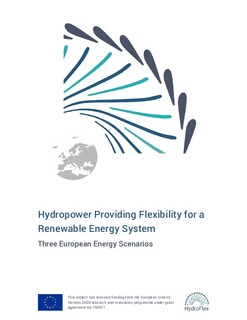| dc.description.abstract | The Horizon 2020 Project ‘Increasing the value of Hydropower through increased Flexibility (HydroFlex)’ aims towards scientific and technological breakthroughs to enable hydropower to operate with very high flexibility in order to utilise the full power and storage capability. The project will create the environmental, social and technical basis for successful future industrial developments by performing well-focused research and innovation activities on the key bottlenecks of hydropower units that restrict their operating range and thus limit their flexibility. One objective of the HydroFlex project is to develop a water turbine capable of doing a significant number of starts and stops per day. Work package 2 aims to investigate if there is a demand for such a turbine in the future power system, for example from an economical perspective in the power markets or from a technical perspective in terms of grid operation and short term system stability. To fulfil this task, simulations of the future European power system are needed. As the future development of the European power system is subject to uncertainty, this report defines three European energy scenarios as a framework to cover various future developments in the simulations. At first, this report explains the status quo of electricity generation in Europe as well as fundamental knowledge related to the term flexibility. Flexibility provision needs to meet certain demands caused by different elements of power systems. This report also presents different flexibility options able to cover these demands for flexibility. Although all provide individual advantages, this report identifies hydropower, especially pumped storage hydropower, to be a very flexible, diverse option and a technology capable of facing flexibility challenges set by the increase of intermittent renewable energy sources. Hydropower is especially common in the Nordic and Alpine countries and might provide flexibility. Assessments of future possibilities regarding this technology should therefore consider hydropower located in these countries. In order to evaluate requirements for hydropower providing flexibility, factors are described, which are essential to the future success of this possibility. As the future is subject to uncertainty, numerous outlines of the future European power system are available, designed by different parties involved in power systems. This report examines existing scenarios on possible opportunities of hydropower based on the mentioned factors. Finally, this report defines three scenarios, the Green Hydro, Reference and Prosumer scenario, which are specifically designed as suitable input for the following computational simulations of the European power systems. To evaluate the possible profitability of hydropower and to achieve HydroFlex’s main objective, the scenarios describe different contexts for Nordic hydropower. | nb_NO |
